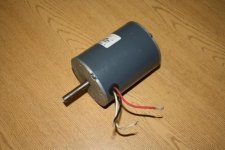Machinery_E
Titanium
- Joined
- Aug 19, 2004
- Location
- Ohio, USA
I have this motor that would be perfect for a project I'm working on, the problem is I can't figure out how to wire it, with what I am assuming needs to be a capacitor? Got it like its shown so I'm not sure how it would be connected? Any ideas? Thanks so much for any help!



